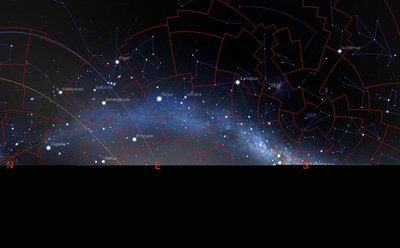Page 1 of 1
APOD: A Kalahari Sky (2017 May 30)
Posted: Tue May 30, 2017 4:06 am
by APOD Robot
 A Kalahari Sky
Explanation:
A Kalahari Sky
Explanation: You wake up in the
Kalahari Desert in
Botswana,
Africa. You go outside your tent, set up your camera, and take
long exposures of the land and sky.
What might you see? Besides a lot of blowing dust and the occasional
acacia tree, you might catch many sky wonders.
Pictured in 2015 September, sky highlights include the
central band of our
Milky Way Galaxy, the
Pleiades Star Cluster,
Barnard's Loop, and both the
Large and Small Magellanic Clouds, to name just a few. Although most of these faded in the morning light, they were quickly replaced by a
partial eclipse of the
Sun.
[/b]
Re: APOD: A Kalahari Sky (2017 May 30)
Posted: Tue May 30, 2017 4:50 am
by Ann
Beautiful image!
Ann
Re: APOD: A Kalahari Sky (2017 May 30)
Posted: Tue May 30, 2017 7:31 am
by Boomer12k
Wow... so much going on... but it's all upside down.... Lol....
Great photo.
Northern hemisphere-er....
:---[===] *
Re: APOD: A Kalahari Sky (2017 May 30)
Posted: Tue May 30, 2017 8:16 am
by ta152h0
Thank you, my aging eyes can still see computer screens
Re: APOD: A Kalahari Sky (2017 May 30)
Posted: Tue May 30, 2017 8:42 am
by JohnD
Beautiful, indeed, but surely a complete construct, courtesy of PhotoShop or similar?
That sky has to have been a long exposure - those glowing clouds are invisible to the eye - so camera was mounted on a motorised stand and the foreground must be a separate image, as it is sharp. Taken in dawn light? Not flash.
Astronomical pictures by scientists, of galaxies, dust clouds etc, are often declared to be 'composites' of many individual images. Why are the excellent, skilled and artistic photographers who work from ground level so shy of making clear their methods?
John
Re: APOD: A Kalahari Sky (2017 May 30)
Posted: Tue May 30, 2017 9:01 am
by heehaw
Great image of the Gum nebula!
Re: APOD: A Kalahari Sky (2017 May 30)
Posted: Tue May 30, 2017 9:14 am
by Nitpicker
JohnD wrote:Beautiful, indeed, but surely a complete construct, courtesy of PhotoShop or similar?
That sky has to have been a long exposure - those glowing clouds are invisible to the eye - so camera was mounted on a motorised stand and the foreground must be a separate image, as it is sharp. Taken in dawn light? Not flash.
Astronomical pictures by scientists, of galaxies, dust clouds etc, are often declared to be 'composites' of many individual images. Why are the excellent, skilled and artistic photographers who work from ground level so shy of making clear their methods?
John
The image details/methods are provided in the "Pictured" link. The camera is modified to be sensitive to IR. No tracking mount would be required for this mosaic/composite of 15 second exposures.
Re: APOD: A Kalahari Sky (2017 May 30)
Posted: Tue May 30, 2017 3:57 pm
by Ann
As a northerner, I still marvel at the fact that you can see Orion and the Large Magellanic Cloud so relatively close to one another in the sky. As long as you're in the Kalahari desert or some other southern location.
Ann
Re: APOD: A Kalahari Sky (2017 May 30)
Posted: Tue May 30, 2017 5:59 pm
by OriEri
As others have already remarked, those of us who grew up under Northern mid latitude skies are easily amused and bemused by how things look different significantly south of the equator. Between things being upside down, and seeing how close together regions, that are to us caelum incognitum, are to objects we know well. It is like if we can't see it, we assume it is distant from anything we know, when in reality it might be just below our horizon...
Re: APOD: A Kalahari Sky (2017 May 30)
Posted: Tue May 30, 2017 8:47 pm
by neufer
https://en.wikipedia.org/wiki/The_Gods_Must_Be_Crazy wrote:
<<Xi and his San tribe of Ju'/Hoansi bushmen are living happily in the Kalahari Desert. One day, a glass Coca-Cola bottle is thrown out of an airplane and falls to Earth unbroken. Initially, Xi's people suppose this strange artifact is another "present" from the gods and find many uses for it. But unlike anything that they have had before, there is only one glass bottle to share. Because of the conflict it causes, Xi consults with elders and agrees to make a pilgrimage to the edge of the world and dispose of the supposedly cursed thing. Xi eventually arrives at God's Window, the top of a cliff with a solid layer of low-lying clouds obscuring the landscape below. Convinced that he has reached the edge of the world, he throws the bottle off the cliff, and returns to his tribe.>>
Re: APOD: A Kalahari Sky (2017 May 30)
Posted: Wed May 31, 2017 12:35 am
by Nitpicker
In case it helps, the (beautiful) APOD shows a panorama of nearly 270 degrees of horizon. Orion and the LMC are separated by ~60 degrees in the sky, but share the same right ascension.

- Blue curve = celestial equator, Beige curve = ecliptic, Brown curve = galactic equator.
 A Kalahari Sky
A Kalahari Sky